Wall tiles for the bathroom
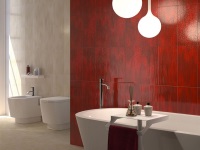
Bathrooms are special in the home because of their special microclimate and not because of the functions they have to fulfil. Because it is especially damp, and because it frequently gets water on the walls and floor, it is important to choose suitable materials for bathroom decoration. Tile will be ideal, as it is not afraid of moisture and easy to clean, which is essential to maintain proper sanitary conditions.
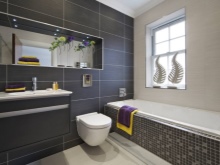
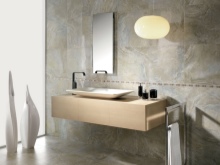
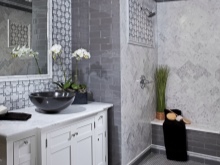
Pros and cons
The demand for ceramic tiles is due to the presence of many positive performance properties, which include:
1. Durability. Quality tiles can last more than a decade, so it is important not to save on this material. In addition, when choosing should pay attention to its strength properties, which indicates the manufacturer on the package.
2. Strength. Tile has high strength and resistance to damage, so accidental blows will not do him any harm. In addition, the material is not afraid of chemicals, which allows the use of cleaning agents containing aggressive components.
3. wide assortment. Finishing material is available in different sizes, shapes and colors, so even the most demanding buyer will find a suitable option.
4. Simple care. To maintain cleanliness, it is enough to periodically wipe the tiles with a sponge, using a soapy solution or a special cleaner. It is not recommended to use abrasive materials, as they can scratch the tile surface.
5. Affordable cost. Wall tiles are presented in different price categories, which depend on its manufacturer, variety, size and characteristics. Even for budget repair you can buy an inexpensive finishing material, but it should be understood that it will be less strong and durable than more expensive products.
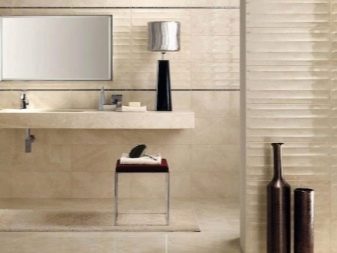
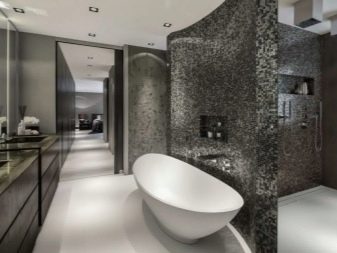
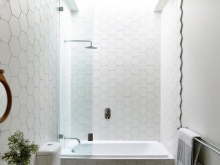
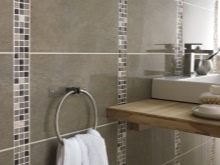
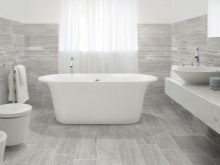
In addition to the advantages, tile still has several disadvantages, for example:
- Without experience and the necessary knowledge, it will be difficult to perform a high-quality tile installation;
- Before you start tiling the walls, they must be carefully aligned;
- In the case of damage to one or more elements, you will have to do the repair again, as it is impossible to replace the tiles locally;
- Tiles should be purchased with a reserve, because in the course of cutting tiles may break, or they simply will not be enough;
- grouting of joints should be carried out very carefully, so that the mortar does not get on the surface of the tiles, otherwise it will be very difficult to get rid of it.


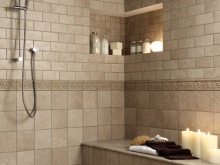
Types
In the production of ceramic tiles, different technologies, techniques, raw materials and forms are used, so the material is divided into several types:
1. Unglazed and glazed. In the first case, the product has a homogeneous thickness, and there are no differences between the utility and the surface. As a rule, such tiles do not have a decorative coating or image. A special feature of glazed tiles is the top coating of colored glass, which provides not only water resistance and high durability, but also aesthetics.
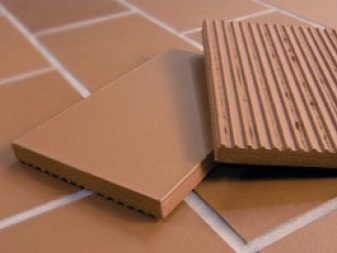
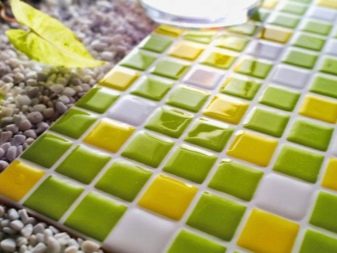
2. Dense and porous base. If utel, i.e. the base, has pores, the product will absorb moisture, so to give the finish durability, it is necessary to additionally treat the surface with a special impregnation. In turn, the material with a dense base has higher performance characteristics, but its mass and cost will also be higher.
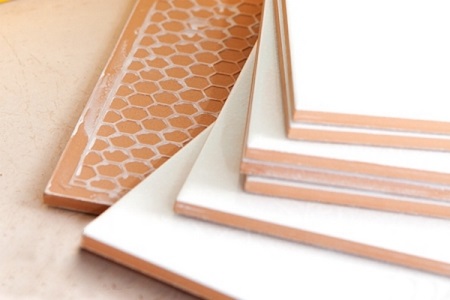
On a colored or white ute. If a glazed tile is purchased, the color of the base does not matter, because it will not be visible. But in the case of unglazed tiles, it will depend on the utel its appearance.
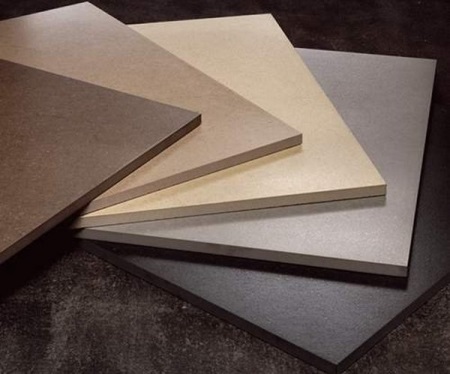
4. Material of single or double firing. Fired twice, the facing has a higher strength. Its surface is usually given an interesting texture, or decorated with a decor.
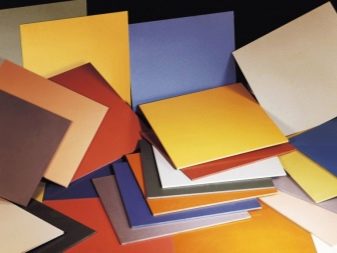
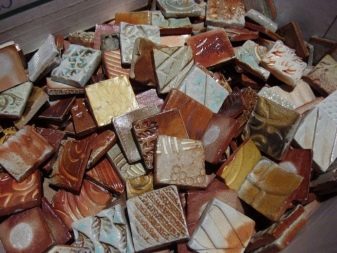
5. Pressed or extruded. The pressing method uses raw material in the form of a powder, which is processed under high pressure. For the extrusion method, a paste-like raw material is used, which is passed through special dies to give the future tiles the necessary shape.
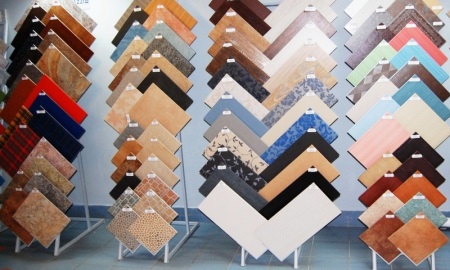
By undertaking repairs, it is recommended to determine in advance the type of facing material, and only after that choose mortars for wall treatment.
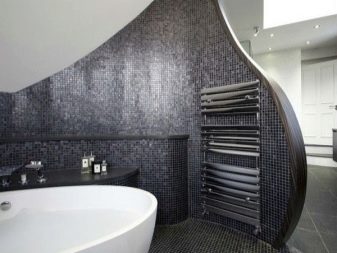

Interesting visual effects
The modern market of finishing materials offers ceramic tiles of different colors and textures, which allows you to create unique interiors in bathrooms.
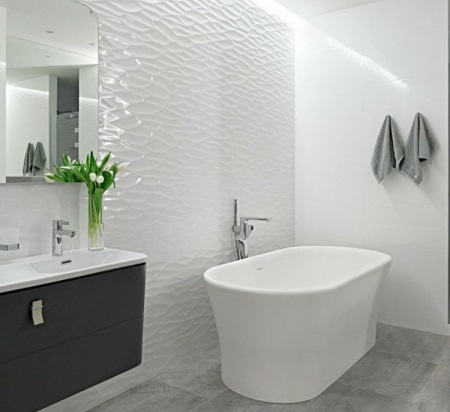
Special attention deserves products with interesting visual effects, which include:
- Tile under wood. Such materials can not only look like natural wood, but also have a similar texture. Products that imitate wood combine well with classic-type finishes.
- Stereo or 3D tiles. This type of cladding material is available both piece by piece and in sets, from which a full picture with the effect of presence is compiled. Typically, for bathrooms choose tile with a picture of water and sea creatures.
- Natural stone tiles. Modern interiors often use elements of natural stone or its analogues, and not only in living rooms, but also in the bathroom. Tile like a stone is not faced with the entire room, and only one wall or a certain area to make the interior design a certain flavor. This type of material has the same texture and relief as natural stone.
- Imitation brick. Tile, which resembles brickwork, performs the same decorative function as the decoration under the stone. On sale there are different variations of the material, which differ in color, size and texture.
- Tiles imitating wallpaper. This finish looks great in the interior, and when properly installed, it is impossible to distinguish it from wallpaper at first glance. The material can be monochrome, with uncomplicated ornaments and with large images made up of 10 or more tiles.
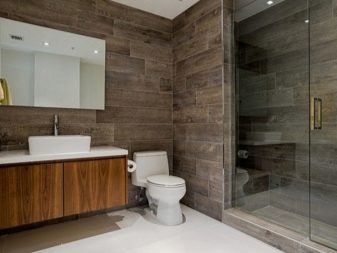
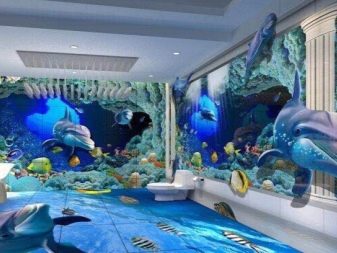
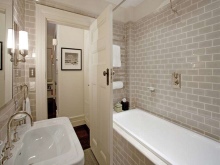
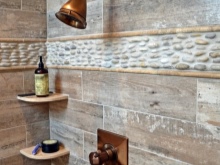
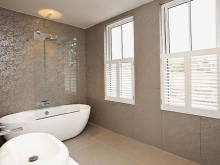
When planning to use tiles with original visual effects, you should remember that their laying requires great experience in the field of repair. In addition, such materials cost much more, and before buying them you need to make accurate measurements of the room, so as not to make a mistake with the amount of material.
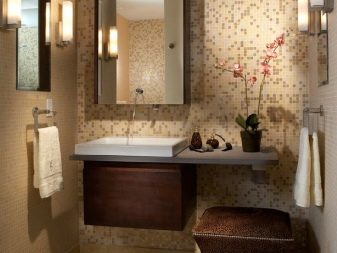
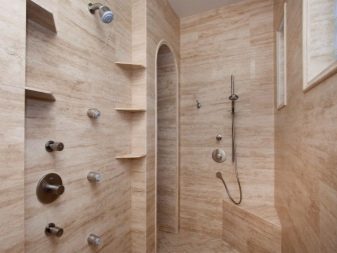
Colors
A wide range of colors of facing tiles gives a huge opportunity to implement various design solutions.
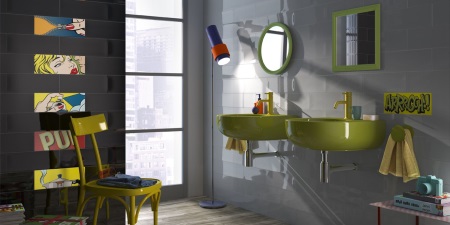
For bathrooms, traditional colors are such as white, blue, light green, blue, pink. As a rule, these tones are taken as a basis, and complemented by darker or brighter elements. Remember that the color scheme of the room depends on its size. Thus, small bathrooms are better tiled with light tiles, but in large rooms you can use dark or bright elements.
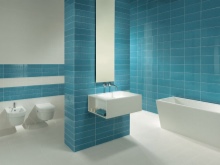
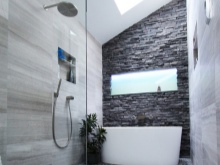
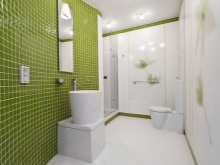
Designers recommend tiling walls with tile of 1-2 colors, but no more. Moreover, the selected tones should go well together, and look harmonious. If you properly place dark and light materials, you can visually change the geometry of the bathroom, for example, to expand the space, to increase the height of the ceiling, or to give the room a regular square shape.
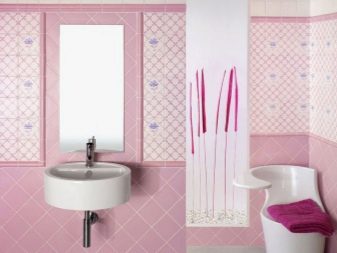
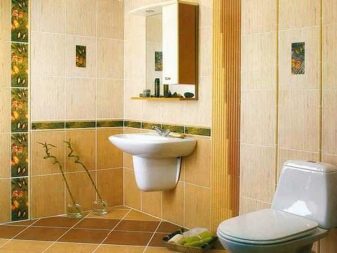
Combination and laying options
Traditionally, for wall cladding in the bathroom, tiles of one size and the same shape are used - square or rectangular, large or medium.

But wishing to create an original interior, masters use all kinds of combinations, for example, rectangular elements are combined with square, large with small. Of course, this option of wall tiling requires skill and a lot of experience, because you need to correctly calculate the number of tiles, and know how it should be placed correctly.
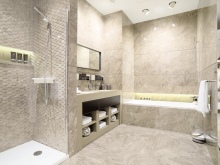
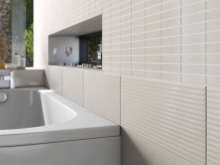
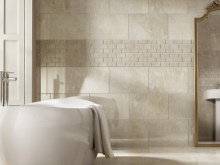
The scheme of laying ceramic tiles will depend not only on personal preferences, but also on the geometry of the bathroom. There are standard and non-standard ways of laying tiles.
The first type includes:
- seam to seam - the elements are laid in even perpendicular rows;
- Diagonal - a complex method of laying, because the tiles must be placed in such a way that the seams were located at an angle of 45 °;
- Intersection - each row is laid with a shift of half of the tiles of the previous row.

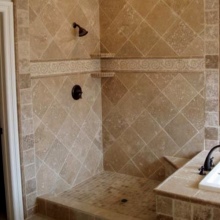
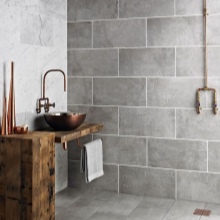
As for non-standard options for laying tiles, they include "herringbone" and "modular grid". In the first case, use elements of rectangular shape, and lay them at an angle of 45 °, but the side of the slope in each row will change. That is, if the first row was placed at a slope to the right, then the next row should be placed at a slope to the left, and so on. As for the "modular grid" scheme, it involves the use of ceramic parts of different shapes and sizes. Of these, a certain fragment is made up, which will be duplicated in the course of facing the wall.
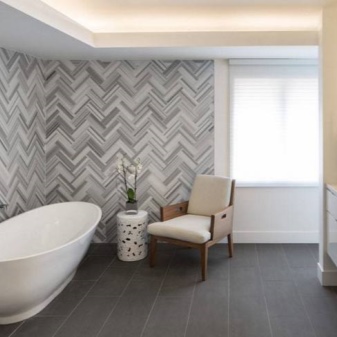
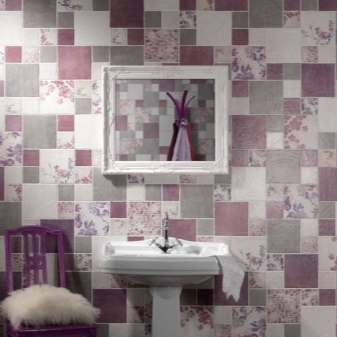
Selection tips
To correctly choose ceramic tiles for wall cladding in the bathroom, it is recommended to pay attention to such aspects as:
- Durability. On the packaging, the manufacturer indicates the strength characteristics of the products, on which will depend on its durability.
- Design. It is recommended to choose a tile with a neutral image and calm tones to create a relaxing atmosphere. If you want to enliven the interior, then it can be complemented by bright elements, but in small quantities.
- Size. In the bathroom, it is desirable to use a tile of medium size, such as 20x30 or 20x20 cm. But if the room is spacious, it is quite acceptable to use materials of large size. Small details, such as mosaics, are best used to a minimum.
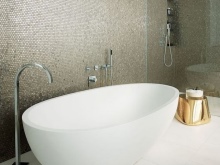
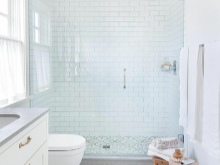
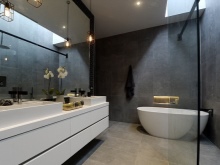
- Ready-made collections. Manufacturers produce complete sets of ceramic tiles for bathrooms, which contain not only the main elements, and decor. Collections are good in that there is no need to independently search for tiles suitable in color and design.
- Practicality. It is recommended to buy facing materials with a smooth surface, without pronounced texture, as they are easier to keep clean.
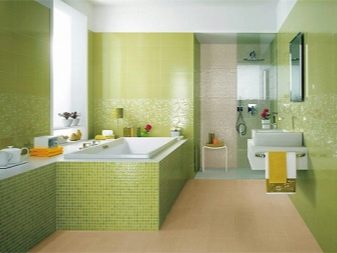
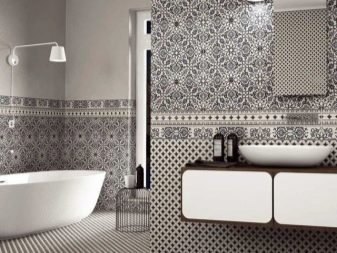
Stylish examples
Tiles with imitation brickwork.
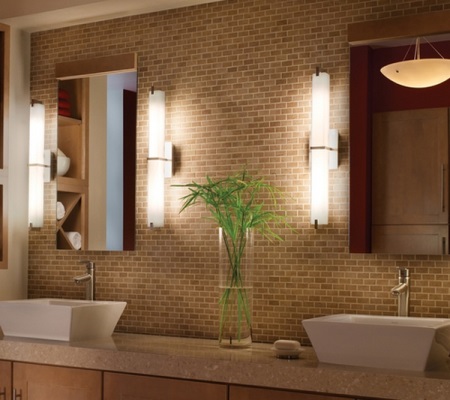
Using tiles with 3D effect it's possible to create an illusion of being in the depths of the sea.
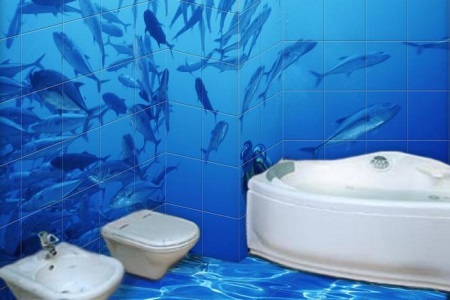
Facing material like wood goes well with white bathroom fixtures.
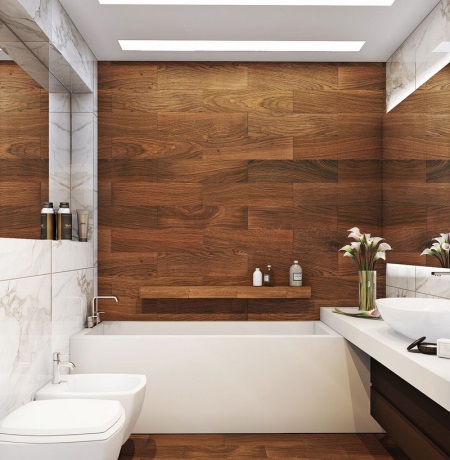
Decorative tile, which imitates natural stone, is better to cover one of the walls, and the others - to finish with a classic material.
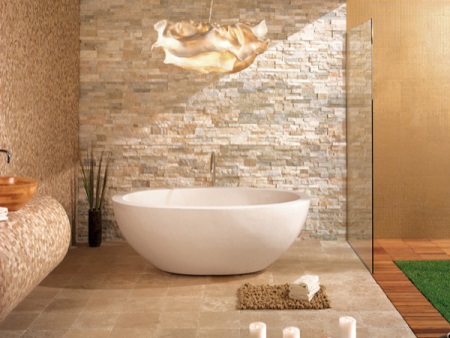
Tiles with a large pattern should be used in small quantities, especially if the room has a small area.
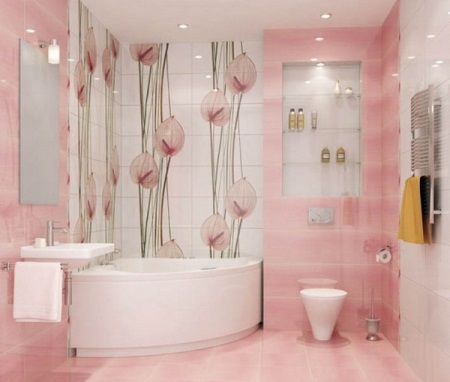
Modular laying with ceramic tiles always looks interesting, but it will be difficult to perform in bathrooms with non-standard configuration.
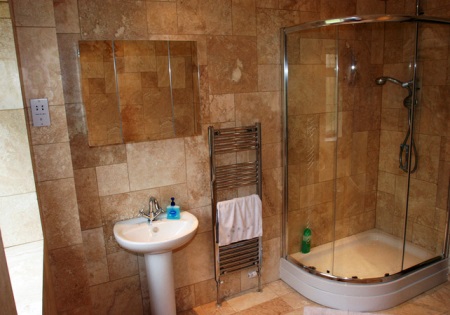
Mosaic paneling will supplement the interior of the bathroom originally, but its laying should be entrusted to a professional.
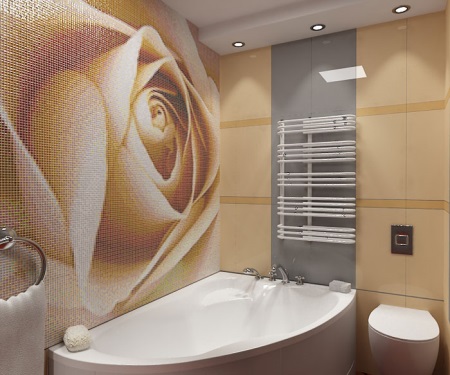
Non-standard solution for finishing the wall - laying rectangular tiles in herringbone order.





